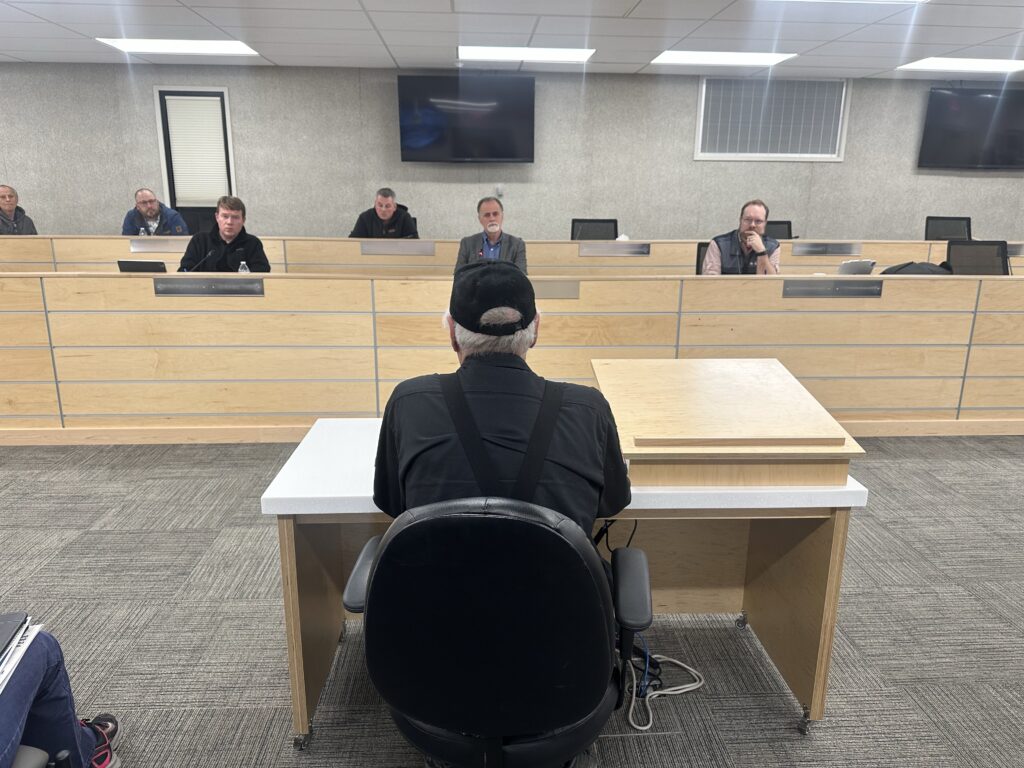Mayor Micciche opened the meeting, welcoming those in attendance, and introduced Commissioner Anderson. For his part, Anderson began by addressing the packed, standing room only, Betty Glick Borough Assembly chambers and offering some of his own personal history, as well as making some initial observations on the brine issue. “We’re in a northern latitude state, and [winter road maintenance] is something that we do, and we have to do a good job. We wanted to make sure we understand what’s going on throughout the state, as well as really honing in on the Kenai to understand what’s going on here.”
Before the meeting was turned over to public testimony, the commissioner asked his legislative liaison, Andy Mills, to provide some clarifications on some of the public’s misconceptions which have developed throughout this process. One such misconception regarded the chemical base for the brine itself, which some have understood to be calcium chloride, a compound that can be more corrosive to metals like those on vehicles. “There are different types of chemicals that are used for anti-icing and deicing. The cheapest and most prevalent one that we use is sodium chloride. Sodium chloride is an effective way a salt that’s rendered from ocean water (that’s how one vendor put it), and that is what is predominantly used in brine for operations here on the Kenai Peninsula.”
Mills has spearheaded the DOT’s investigation into claims that the brine is one of the primary — if not the most substantial — causes of the increased vehicle body and component corrosion seen by auto shop workers and owners.
Once Mills finished sharing and the floor was opened to the public, a steady stream of peninsula locals lined up at the microphone to voice their concerns. The majority of the roughly two hours of testimony consisted of men and women, representing either themselves or a business, sharing personal experiences of brine-induced corrosion. In total, 38 people sat before the commissioner to speak out — 37 of whom were opposed to the brine’s use, and one in favor.
Many of the comments addressed safety concerns. Several people shared about experiences with corroded and failed break lines, corroded vehicle frames, as well as other vehicle components, several leading to car accidents, some of which led to injury as well as substantial vehicle damage. Others spoke of nearly missed accidents, which could have resulted in severe injury or worse. In all of these anecdotes, corroded vehicle components were the primary contributing factor.
Another hazard of note was moose, who are very fond of licking the salt brine residue from roads, and occasionally from vehicles themselves. In some cases, testimonies cited incidents of moose stopping in the middle of bridges where higher concentrations of the brine tend to collect. For anyone who has lived in Alaska more than a year or so, vehicle-moose collisions are a constant danger, especially with the reduced daylight hours during winter. According to these testimonies, the salt brine significantly increases the risk of moose collisions.
Perhaps one of the most impactful concerns raised was an extension of the costs associated with corrosion-caused vehicle damage. Namely, the impact such unexpected costs have on lower income families. According to some of the public testimony, local teachers have observed instances of quality of life reductions for some of their students, then later found out that the student’s family had been forced to forego certain basic needs in order to pay for the replacement of critical vehicle parts, like brakes, which had failed due to excessive corrosion.
Several local politicians were also present to offer their thoughts, both as community leaders and private citizens.
“Just recently I was up at an auction for a local trucking company that was selling a bunch of trucks up in Anchorage,” said Kenai City Council member, Alex Douthit. “[There were] 15 to 20 trucks in a line, all the same age, all up for auction. I talked to the mechanic and the fleet manager and I said, ‘So which ones here are the government’s?’ He goes, ‘Well, you see all the ones with the scaly rust and the whole frame looks like it’s gonna fall apart? Those are all Kenai trucks. You don’t want anything from Kenai.’”
“The people here don’t want a reduction, they want an elimination, and we’ve got the trucks and we’ve got the people [to do it],” said State Congressman, Representative Ben Carpenter after Commissioner Anderson explained the DOT’s plan to reduce brine usage this winter. “Please help me understand what the options are and what the costs are so that we can get to a point where we’re not using the brine, because that’s what the people want. I get that the administration wants to be able to use it for certain reasons, but the people don’t want it.”
Afterward, Commissioner Anderson spoke briefly with KSRM, and offered some summary thoughts on the meeting. “What people said tonight was a concern about safety. There were concerns about health and a lot of other different points that you know, we’re just gonna have to go back and take point by point cause we need to address all of it. I think we’ve been doing a lot in the past and I think the borough has communicated very well with DOT and so we’ve been hearing a lot of these concerns as they’ve been coming out and so we’re gonna keep working through that.”
Overall, the meeting was a successful example of the process by which the public can raise its voice with concerns and be heard by those in charge. Throughout the meeting, Commissioner Anderson, and his liaison Mills, could been seen taking pages and pages of notes as one testimony after another came before them.
The meeting also appeared to be received with round optimism. The majority of those who spoke were concise, articulate and respectful as they addressed the commissioner, and the majority seemed more interested in simply sharing primary concerns for the health and well being of their friends, family, and community, than pointing fingers or questioning DOT judgement or integrity.
The meeting materialized through the collaborate effort of both public pressure for change, and political cooperation from borough leadership. In response to the magnitude of the public outcry against the brine, Mayor Peter Micciche penned a letter to the commissioner, raising the community’s concerns, and requesting a prompt DOT response. In the letter, Mayor Micciche acknowledges the DOT’s position on the purpose and intent behind the brine, but also presses the options raised by the people of his borough;
“I want to make it clear that I share AKDOTs concern for safety and I have heard that the application of brine results in safer conditions at a given cost per unit/effort. However, alternatives to brine exist, including sand and more frequent and timely mechanical removal of snow/ice from the roads. While these alternatives no doubt are more costly to the department, some consideration should be given to the increased costs to individuals in vehicle repairs and potential mechanical/electrical failures resulting from the application of the more corrosive alternative.”
According to the commissioner, the community can expect a response from the DOT within the next week regarding its immediate plans for winter road care. As for a permanent long term solution, that likely won’t be provided until 2024.
*This is an updated version of the same story, which was published on October 12th, 2023.

